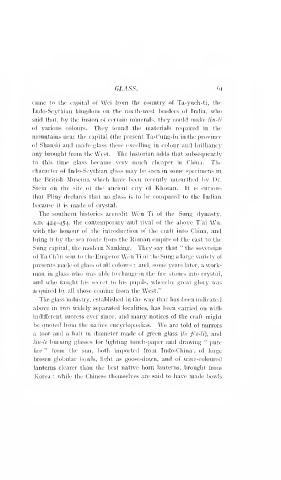Page 225 - Chinese Art, Vol II By Stephen W. Bushell
P. 225
GLASS. 6i
came to the capital of Wei from the country of Ta-yueh-ti, the
Indo-Scythian kingdom on the north-west borders of India, who
said that, by the fusion of certain minerals, they could make liti-li
of various colours. They found the materials required in the
mountains near the capital (the present Ta-t'ung-fu in the province
of Shansi) and made glass there excelling in colour and brilliancy
any brought from the West. The historian adds that subsequently
to this time glass became very much cheaper in China. The
character of Indo-Scythian glass may be seen in some specimens in
the British Museum which have been recently unearthed by Dr.
Stein on the site of the ancient city of Khotan. It is curious
that Pliny declares that no glass is to be compared to the Indian
because it is made of crystal.
The southern histories accredit Wen Ti of the Sung dynasty,
A.D. 424-454, the contemporary and rival of the above T'ai Wu,
with the honour of the introduction of the craft into China, and
bring it by the sea route from the Roman empire of the east to the
Sung capital, the modern Nanking. They say that " the sovereign
of Ta Ch'in sent to the Emperor Wen Ti of the Sung a large variety of
presents made of glass of all colours ; and, some years later, a work-
man in glass who was able to change in the fire stones into crystal,
and who taught his secret to his pupils, whereby great glory was
acquired by all those coming from the West."
The glass industry, established in the way that has been indicated
above in two widely separated localities, has been carried on with
indifferent success ever since, and many notices of the craft might
be quoted from the native encyclopaedias. We are told of mirrors
a foot and a half in diameter made of green glass (/// p'o-li), and
liu-li burning glasses for lighting touch-paper and drawing " pure
fire " from the sun, both imported from Indo-China : of large
brown globular l)owls, light as goose-down, and of wine-coloured
lanterns clearer than the best native horn lanterns, brought from
Korea : while the Chinese themselves are said to have made bowls

